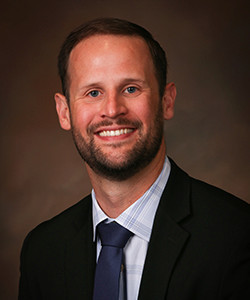
Bioengineering research allowed me to use my problem-solving skills to advance medicine and fulfill my inherent desire to help others.
It may seem odd to call new University of Utah bioengineering assistant professor Lucas Timmins a “rock n’ roll researcher,” but in a way, that’s what he is. When he’s not studying the properties of cardiovascular tissue for the benefit of life-saving medical devices, he can be seen thrashing on his guitar in a band called BEDrock, made up of other bioengineering researchers.
Q: Where are you from originally, and how did you first become interested in medicine and bioengineering? Was that a passion that started when you were young?
A: I grew up in Port Neches, Texas, which is a small coastal town near the Texas-Louisiana border. Growing up I always enjoyed math and science during primary and secondary education, and, like a typical engineer, I remained fascinated with understanding how things worked, which included taking apart countless electronics and never putting them back together. (Sorry, Mom.) However, medicine always captivated me. Particularly, the impactful role that physicians and health care professionals have on the well-being of society. It was not until high school when I became aware of bioengineering, and, given my interest, it seemed like a natural fit to pursue in college.
Although I enrolled in biomedical engineering at Texas A&M University, my plan was to pursue a career in medicine following graduation. It was not until I began conducting research in a biomechanics lab that I understood how bioengineering research could affect patient care. Bioengineering research allowed me to use my problem-solving skills to advance medicine and fulfill my inherent desire to help others. Ultimately, I stayed in that biomechanics lab to conduct my Ph.D. studies.
Q: Tell us about your research group and its focus on the role of biomechanics in cardiovascular disease.
A: I direct the Cardiovascular Pathomechanics (CVPM) Laboratory, and we are a multidisciplinary group that studies the role of biomechanics in cardiovascular disease development, progression, and therapeutic intervention. We aim to develop experimental and computational approaches to characterize physiologic mechanical environments and understand how mechanical stimuli drive pathologic processes with the underlying goal of advancing diagnosis and informing clinical management decisions. As much of our focus is directed at advancing patient care, we maintain active collaborations with clinicians and clinical-scientists at the School of Medicine.
Q: What are some of the various remedies you are researching in which it’s important to understand how vascular tissue reacts to them?
A: The biomechanical environment is a key factor in cardiovascular disease development, and our research leverages this understanding to advance patient care. One key area of interest in our lab is to understand the relationship between mechanical loads, which we predict with image-based modeling strategies, and clinical disease development and progression. For example, we have projects directed at identifying patients at greater risk for a heart attack based on the biomechanical environment in their coronary arteries and developing treatment strategies to minimize the failure of vascular stents — the devices used to restore blood flow to clogged arteries — by optimizing stent design to minimize their mechanical ‘footprint’.
Other research activities in our group are directed at better understanding the relationship between vascular tissue structure and function, including material characterization of these complex tissues and examining tissue remodeling during atherosclerosis development.
Q: Tell us about why you came to the University of Utah. What was attractive about the university’s bioengineering department that made you want to come here to continue your research?
A: The Department of Bioengineering has established strengths in biomechanics, image-based modeling and scientific computing, which encompass my research areas. Combined with the outstanding research infrastructure, outstanding colleagues and talented undergraduate and graduate students, the department was an ideal setting to establish my research career. In addition, the proximity of the School of Medicine and the internationally-recognized research being conducted in upper campus were very attractive. A bioengineering department that has such direct access to faculty and clinicians to assist in advancing and translating our research efforts is hard to find at other institutes, yet integral to addressing unmet challenges in medicine. I am continually impressed by how friendly everyone is across the University, and that has allowed me to establish numerous multidisciplinary collaborations across campus.
Q: When you aren’t researching how to improve people’s health, you’re also rockin’ the house with other researchers. What’s that all about?
A: I am a member of the Bioengineering Division (BED) rock band, BEDrock, which is comprised of biomechanics faculty from across the world, including bioengineering faculty member, Jeff Weiss, and U of U alumnus Spencer Lake from Washington Univ. in St. Louis. The band started as just a group of biomechanicians, who shared a common interest in music, that would get together to jam, but we are now are a part of the conference program and play for our colleagues during one evening of the annual summer conference. I play guitar and bass, and it’s an absolute blast. But playing in front of several hundred people can be a bit more stressful than giving a presentation at a conference.